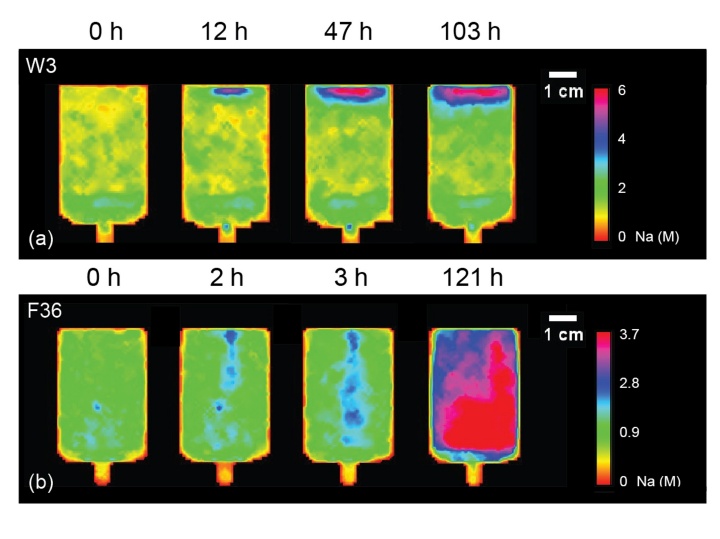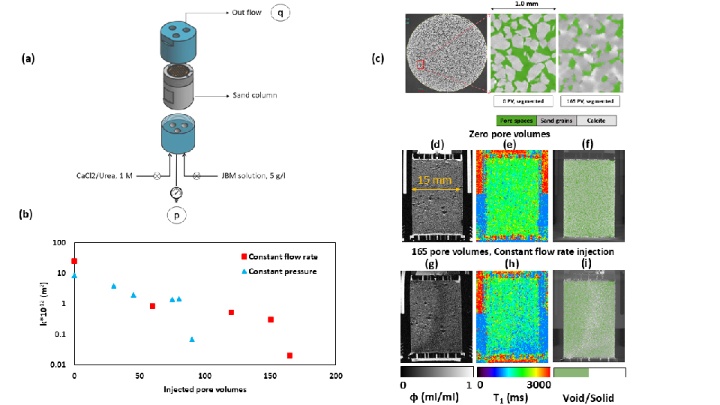Publications
Preprints
- Chaudhry, M. A., Kiemle, S., Pohlmeier, A., Helmig, R., & Huisman, J. A. (2025). Non-invasive imaging of solute redistribution below evaporating surfaces using 23Na-MRI. In arXiv preprint arXiv:2504.00216. https://doi.org/10.48550/arXiv.2504.00216
(Journal-) Articles
- Krach, D., Ruf, M., & Steeb, H. (2025). POREMAPS: A finite difference based Porous Media Anisotropic Permeability Solver for Stokes flow. InterPore Journal, 2, Article 1. https://doi.org/10.69631/ipj.v2i1nr39
- Gravelle, S., Haber-Pohlmeier, S., Mattea, C., Stapf, S., Holm, C., & Schlaich, A. (2023). NMR Investigation of Water in Salt Crusts: Insights from Experiments and Molecular Simulations. Langmuir, 39, 7548–7556. https://doi.org/10.1021/acs.langmuir.3c00036
- Lee, D., Weinhardt, F., Hommel, J., Piotrowski, J., Class, H., & Steeb, H. (2023). Machine learning assists in increasing the time resolution of X-ray computed tomography applied to mineral precipitation in porous media. Scientific Reports, 13. https://doi.org/10.1038/s41598-023-37523-0
- Wieboldt, R., Lindt, K., Pohlmeier, A., Mattea, C., Stapf, S., & Haber-Pohlmeier, S. (2023). Effects of Salt Precipitation in the Topmost Soil Layer Investigated by NMR. Applied Magnetic Resonance, 54, 1607–1631. https://doi.org/10.1007/s00723-023-01568-1
- Erfani, H., Karadimitriou, N. K., Nissan, A., Walczak, M. S., An, S., Berkowitz, B., & Niasar, V. (2021). Process-Dependent Solute Transport in Porous Media. Transport in Porous Media, 140, 421–435. https://doi.org/10.1007/s11242-021-01655-6
- Gao, H., Tatomir, A. B., Karadimitriou, N. K., Steeb, H., & Sauter, M. (2021). Effects of surface roughness on the kinetic interface-sensitive tracer transport during drainage processes. Advances in Water Resources, 157. https://doi.org/10.1016/j.advwatres.2021.104044
- Weinhardt, F., Class, H., Dastjerdi, S. V., Karadimitriou, N. K., Lee, D., & Steeb, H. (2021). Experimental Methods and Imaging for Enzymatically Induced Calcite Precipitation in a Microfluidic Cell. Water Resources Research, 57. https://doi.org/10.1029/2020wr029361
- Yiotis, A., Karadimitriou, N. K., Zarikos, I., & Steeb, H. (2021). Pore-scale effects during the transition from capillary- to viscosity-dominated flow dynamics within microfluidic porous-like domains. Scientific Reports, 11. https://doi.org/10.1038/s41598-021-83065-8
- Hasan, S., Niasar, V., Karadimitriou, N. K., Godinho, J. R. A., Vo, N. T., An, S., Rabbani, A., & Steeb, H. (2020). Direct characterization of solute transport in unsaturated porous media using fast X-ray synchrotron microtomography. Proceedings of the National Academy of Sciences of the United States of America, 117, 23443–23449. https://doi.org/10.1073/pnas.2011716117
- Konangi, S., Palakurthi, N. K., Karadimitriou, N. K., Comer, K., & Ghia, U. (2020). Comparison of Pore-scale Capillary Pressure to Macroscale Capillary Pressure using Direct Numerical Simulations of Drainage under Dynamic and Quasi-static Conditions. Advances in Water Resources, 147. https://doi.org/10.1016/j.advwatres.2020.103792
- Piotrowski, J., Huisman, J. A., Nachshon, U., Pohlmeier, A., & Vereecken, H. (2020). Gas Permeability of Salt Crusts Formed by Evaporation from Porous Media. Geosciences, 10. https://doi.org/10.3390/geosciences10110423
- Poonoosamy, J., Haber-Pohlmeier, S., Deng, H., Deissmann, G., Klinkenberg, M., Gizatullin, B., Stapf, S., Brandt, F., Bosbach, D., & Pohlmeier, A. (2020). Combination of MRI and SEM to Assess Changes in the Chemical Properties and Permeability of Porous Media due to Barite Precipitation. Minerals, 10. https://doi.org/10.3390/min10030226
- Ruf, M., & Steeb, H. (2020). An open, modular, and flexible micro X-ray computed tomography system for research. Review of Scientific Instruments, 91. https://doi.org/10.1063/5.0019541
- Hasan, S. N., Joekar-Niasar, V., Karadimitriou, N., & Sahimi, M. (2019). Saturation-Dependence of Non-Fickian Transport in Porous Media. Water Resources Research, 55, 1153–1166. https://doi.org/10.1029/2018WR023554
- Karadimitriou, N. K., Mahani, H., Steeb, H., & Niasar, V. (2019). Nonmonotonic Effects of Salinity on Wettability Alteration and Two-Phase Flow Dynamics in PDMS Micromodels. Water Resources Research, 55, 9826–9837. https://doi.org/10.1029/2018wr024252
- Steeb, H., & Renner, J. (2019). Mechanics of Poro-Elastic Media: A Review with Emphasis on Foundational State Variables. Transport in Porous Media, 130, 437–461. https://doi.org/10.1007/s11242-019-01319-6
- Yin, X., Zarikos, I., Karadimitriou, N. K., Raoof, A., & Hassanizadeh, S. M. (2019). Direct simulations of two-phase flow experiments of different geometry complexities using Volume-of-Fluid (VOF) method. Chemical Engineering Science, 195, 820–827. https://doi.org/10.1016/j.ces.2018.10.029
Published data sets
- Krach, D., Ruf, M., & Steeb, H. (2024). POREMAPS 1.0.0: Code, Benchmarks, Applications [DaRUS]. https://doi.org/10.18419/DARUS-3676
- Gravelle, S. (2023). Molecular simulation scripts for slit nanopores with tunable hydrophilicity [DaRUS]. https://doi.org/10.18419/DARUS-3732
- Gravelle, S., Holm, C., & Schlaich, A. (2023). Molecular simulation scripts for bulk solutions [DaRUS]. https://doi.org/10.18419/DARUS-3179
- Gravelle, S., Holm, C., & Schlaich, A. (2023). Molecular simulation scripts for slit nanopores [DaRUS]. https://doi.org/10.18419/DARUS-3180
- Lee, D., & Steeb, H. (2023). Image enhancement code: time-resolved tomograms of EICP application using 3D U-net [DaRUS]. https://doi.org/10.18419/DARUS-2991
- Lee, D., Weinhardt, F., Hommel, J., Class, H., & Steeb, H. (2023). Time resolved micro-XRCT dataset of Enzymatically Induced Calcite Precipitation (EICP) in sintered glass bead columns [DaRUS]. https://doi.org/10.18419/DARUS-2227
Research
About the Project
Fluid-solid reactions pose a challenge for modelling flow and transport in porous media due to the dynamic changes in the pore space and the associated alteration of the permeability. This project aims to use Magnetic Resonance Imaging (WRI) and X-ray computer microtomography (µXRCT) measurements in combination with flow and transport experiments on the REV scale to improve understanding of how reactions at the fluid-solid interface affect flow and transport in porous media.
Results
Funding Period 1
In the first funding period, we focused on salt precipitation due to evaporation from porous media as an exemplary solid-fluid reactions. This process leads to the formation of a salt crust that affects the flow and transport of water and solutes in the top layer of a porous media, and causes amongst others soil salinization, erosion and land loss, and damage to building materials.
A key result was the investigation of the permeability of salt crusts that form on top (efflorescence) or inside (subflorescence) of the porous medium for which we developed a gas permeameter set-up. Although efflorescent and subflorescent salt crusts developed differently, the gas permeability of the dried crusts were similar and within one order of magnitude. µXRCT scans of subflorescent MgSO4 crusts (Figure 1) revealed the deformation of the porous medium by salt precipitation. This in conflict with the common assumption that subflorescent precipitation occurs within a rigid porous structure. Overall, the experimental insights helped to understand the impact of precipitation on evaporation on the pore scale. The information and the evolution of porosity and REV-scale permeability can be used to improve Darcy-scale models that describe the evaporation of saline solution from porous media. This formed the basis for collaborations with SFB project areas A and C as well as associated projects.
Left: Volume fraction of sand, salt, and voids as a function of depth for a MgSO4 crust in medium sand obtained from segmentation of XRCT images. The yellow dashed line indicates the gravimetrically determined original sand fraction before salt precipitation. Right: Representative slice inside the crust indicated by the black dashed line with a resolution of 4 mm and a diameter of 12 mm.
Funding Period 2
In the current (second) funding phase, we continued to investigate solute dynamics and salt precipitation associated with evaporation. A key results was obtained together with project A02 and associated researcher Stefanie Kiemle (CX5). We investigated density-driven downward redistribution of solutes during evaporation for soils with a supply of water from below using MRI (Figure 2). Strong differences in solute concentration distributions were observed for samples with different intrinsic permeability, and the implications for evaporation rates and time to the start of crust formation were confirmed in a wind tunnel experiment performed together with external partner Nima Shokri from the Technical University Hamburg. Numerical simulations with DuMux were able to reproduce both evaporation experiments.

We also investigated a second solid-fluid reaction: induced calcite precipitation. In collaboration with project C04, we investigated how different injection strategies for enzyme-induced calcite precipitation (EICP) affected the intrinsic permeability as well as the distribution of calcite precipitation as determined both MRI and XRCT. The results showed that constant pressure injection led to a faster reduction of permeability and a more homogeneous precipitation distribution compared to constant flow injection (Figure 3). This confirms previous findings of project C04 obtained with microfluidic experiments.

Future Work
For the third funding period, we propose to extend the aim of the project and also focus on how interactions between fluid-solid reactions and deformation affect flow and transport in porous media. The work will be focused on:
- Development of an experimental benchmark for evaporation-induced salt precipitation in highly controlled experimental conditions using the advanced experimental facilities of the CRC 1313 (with project A06 and Z02). This unique experimental benchmark with quantified uncertainty will be used to organize a community-wide benchmark study to evaluate the performance of REV-scale models together with project D03.
- Deformation during subflorescent salt precipitation for different salt types and environmental conditions using a novel set-up to determine strain of granular samples. Selected samples will also be investigated using time-lapse XRCT imaging to obtain detailed 3D information on deformation, and to assess the importance of this deformation for evaporation processes.
- Desiccation cracking of evaporating porous media through time-lapse imaging with a digital camera. Thin samples of bentonite clay will be investigated to obtain information on how salt type, solute concentration, and salt precipitation affect desiccation cracking. This will be followed by experiments with thicker soil samples, where more intricate hydromechanical interactions are anticipated. This work will be jointly done with B02, where a model for desiccation cracking will be developed.
The REV-scale experiments on evaporation-induced salt precipitation are a central component of the “salt vision” of the overall CRC. The acquired data will be important for the further development and validation of both pore-scale and REV-scale modelling approaches for coupled free-flow porous-media flow in the benchmark study “evaporation-induced salt precipitation” that will be developed together with A06 and D03.
(Inter)national Cooperation
Technical University Hamburg
Together with external partner Nima Shokri, we performed wind tunnel experiments to verify that density-driven redistribution of solutes lead to a delayed start of salt crust formation.
Montana State University, USA
The work on induced calcite precipitation benefits from the close connection of the CRC 1313 with the Montana State University in Bozeman, USA.
Volcani Institute, Israel
We joined forces in the first funding phase with Uri Nachshon from the Volcani Institute. Together, we developed the gas permeameter set-up and jointly analyzed the permeability and XRCT measurements.
For further information please contact

J. A. (Sander) Huisman
Prof. Dr.Project Leader, Research Project C05

Andreas Pohlmeier
Dr.Project Leader, Research Project C05

Holger Steeb
Prof. Dr.-Ing.Spokesman, Project Leader, Research Projects B05, C05, and Z02, Project WIKO, Central Project Z


